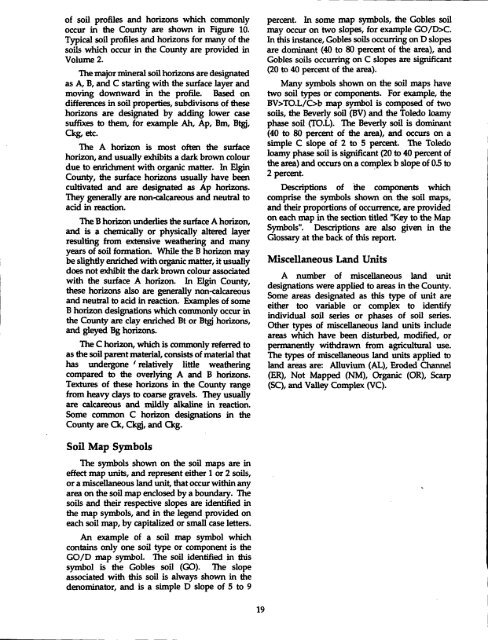The Soils of Elgin County - Agriculture and Agri-Food Canada
The Soils of Elgin County - Agriculture and Agri-Food Canada
The Soils of Elgin County - Agriculture and Agri-Food Canada
- No tags were found...
Create successful ePaper yourself
Turn your PDF publications into a flip-book with our unique Google optimized e-Paper software.
<strong>of</strong> soil pr<strong>of</strong>iles <strong>and</strong> horizons which commonlyoccur in the <strong>County</strong> are shown in Figure 10.Typical soil pr<strong>of</strong>iles <strong>and</strong> horizons for many <strong>of</strong> thesoils which occur in the <strong>County</strong> are provided inVolume 2.<strong>The</strong> major mineral soil horizons are designatedas A, B, <strong>and</strong> C starting with the surface layer <strong>and</strong>moving downward in the pr<strong>of</strong>ile. Based ondifferences in soil properties, subdivisons <strong>of</strong> thesehorizons are designated by adding lower casesuffixes to them, for example Ah, Ap, Bm, Btgj,Ckg, etc .<strong>The</strong> A horizon is most <strong>of</strong>ten the surfacehorizon, <strong>and</strong> usually exhibits a dark brown colourdue to enrichment with organic matter . In <strong>Elgin</strong><strong>County</strong>, the surface horizons usually have beencultivated <strong>and</strong> are designated as Ap horizons .<strong>The</strong>y generally are non-calcareous <strong>and</strong> neutral toacid in reaction .<strong>The</strong>B horizon underlies the surfaceA horizon,<strong>and</strong> is a chemically or physically altered layerresulting from extensive weathering <strong>and</strong> manyyears <strong>of</strong> soil formation. While the B horizon maybe slightly enriched with organic matter, it usuallydoes not exhibit the dark brown colour associatedwith the surface A horizon. In <strong>Elgin</strong> <strong>County</strong>,these horizons also are generally non-calcareous<strong>and</strong> neutral to acid in reaction. Examples <strong>of</strong> someB horizon designations which commonly occur inthe <strong>County</strong> are clay enriched Bt or Btgj horizons,<strong>and</strong> gleyed Bg horizons.<strong>The</strong> C horizon, which is commonly referred toas the soil parent material, consists <strong>of</strong> material thathas undergone I relatively little weatheringcompared to the overlying A <strong>and</strong> B horizons.Textures <strong>of</strong> these horizons in the <strong>County</strong> rangefrom heavy clays to coarse gravels. <strong>The</strong>y usuallyare calcareous <strong>and</strong> mildly alkaline in reaction .Some common C horizon designations in the<strong>County</strong> are Ck, Ckgj, <strong>and</strong> Ckg.percent. In some map symbols, the Gobles soilmay occur on two slopes, for example GO/D>C .In this instance, Gobles soils occurring on D slopesare dominant (40 to 80 percent <strong>of</strong> the area), <strong>and</strong>Gobles soils occurring on C slopes are significant(20 to 40 percent <strong>of</strong> the area) .Many symbols shown on the soil maps havetwo soil types or components . For example, theBV>TO.L/C>b map symbol is composed <strong>of</strong> twosoils, the Beverly soil (BV) <strong>and</strong> the Toledo loamyphase soil (TOI). <strong>The</strong> Beverly soil is dominant(40 to 80 percent <strong>of</strong> the area), <strong>and</strong> occurs on asimple C slope <strong>of</strong> 2 to 5 percent. <strong>The</strong> Toledoloamy phase soil is significant (20 to 40 percent <strong>of</strong>the area) <strong>and</strong> occurs on a complexb slope <strong>of</strong> 0.5 to2 percent.Descriptions <strong>of</strong> the components whichcomprise the symbols shown on the soil maps,<strong>and</strong> their proportions <strong>of</strong> occurrence, are providedon each map in the section titled "Key to the MapSymbols". Descriptions are also given in theGlossary at the back <strong>of</strong> this report .Miscellaneous L<strong>and</strong> UnitsA number <strong>of</strong> miscellaneous l<strong>and</strong> unitdesignations were applied to areas in the <strong>County</strong> .Some areas designated as this type <strong>of</strong> unit areeither too variable or complex to identifyindividual soil series or phases <strong>of</strong> soil series .Other types <strong>of</strong> miscellaneous l<strong>and</strong> units includeareas which have been disturbed, modified, orpermanently withdrawn from agricultural use .<strong>The</strong> types <strong>of</strong> miscellaneous l<strong>and</strong> units applied tol<strong>and</strong> areas are: Alluvium (AL), Eroded Channel(ER), Not Mapped (NM), Organic (OR), Scarp(SC), <strong>and</strong> Valley Complex (VC) .Soil Map Symbols<strong>The</strong> symbols shown on the soil maps are ineffect map units, <strong>and</strong> represent either 1 or 2 soils,or a miscellaneous l<strong>and</strong> unit, that occur within anyarea on the soil map enclosed by a boundary. <strong>The</strong>soils <strong>and</strong> their respective slopes are identified inthe map symbols, <strong>and</strong> in the legend provided oneach soil map, by capitalized or small case letters.An example <strong>of</strong> a soil map symbol whichcontains only one soil type or component is theGO/D map symbol. <strong>The</strong> soil identified in thissymbol is the Gobles soil (GO) . <strong>The</strong> slopeassociated with this soil is always shown in thedenominator, <strong>and</strong> is a simple D slope <strong>of</strong> 5 to 919
















